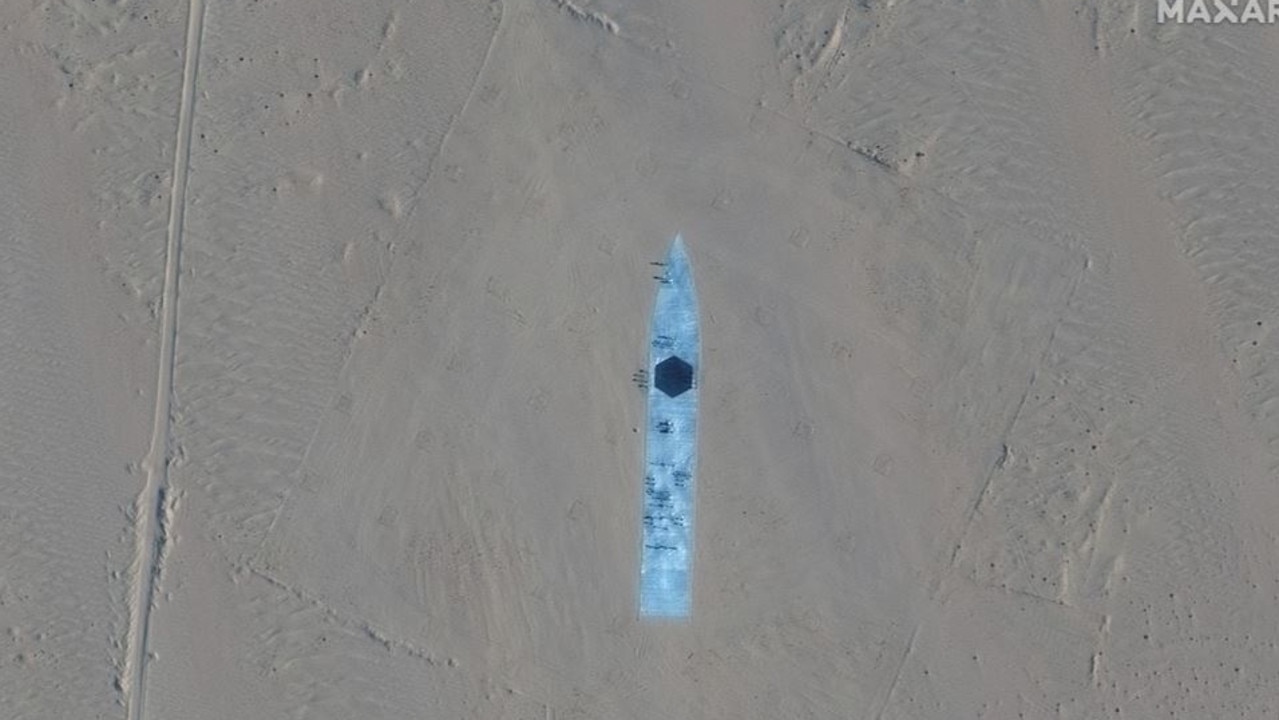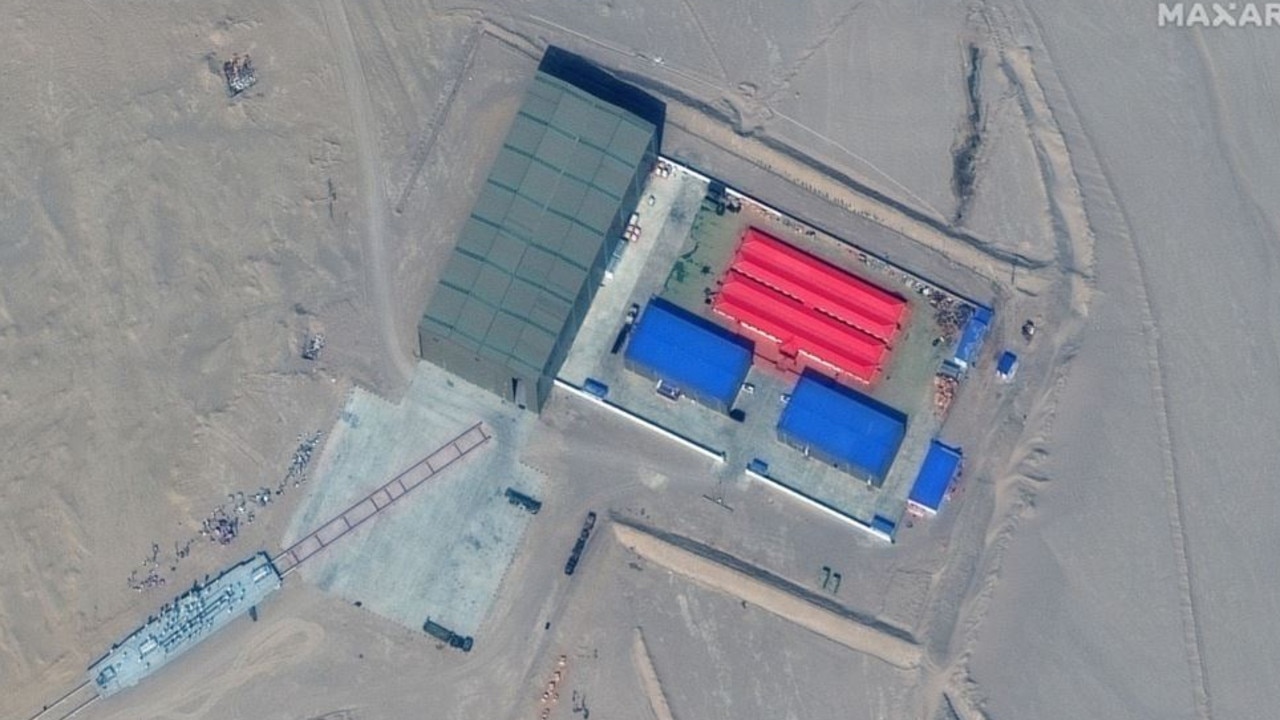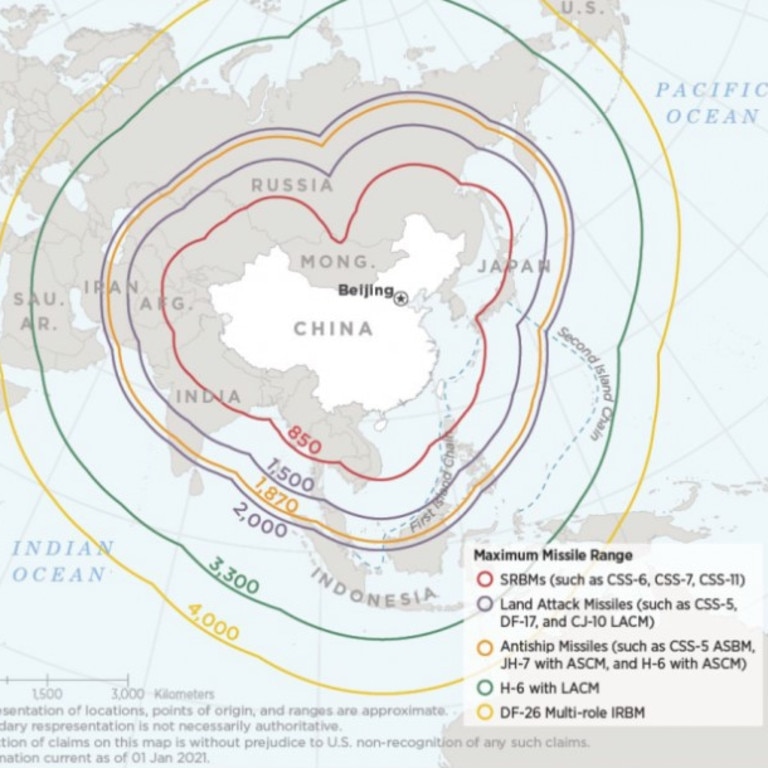
Satellite pictures reveal China’s disturbing missiles plan
New satellite photos show what China’s plan could be for their powerful hypersonic missiles – and the entire world should be worried.
Australia has been accused of “napping at the wheel” while China has amassed a devastating arsenal of hi-tech, long-range weapons.
Watch out Pearl Harbor: last year, satellites caught Beijing building mock-ups of warships in the desert.
Now a new batch reveals some represented ships in port – with craters proving they can be picked out from among the clutter of piers and docks.
Do the new satellite photos reveal China may be planning a new “day of infamy”?
A United States Naval Institute (USNI) report argues commercial satellite photos show China’s People’s Liberation Army is developing a disturbing new military capability: hypersonic missiles that can identify and hit warships sitting idle in their home ports.
It’s a scenario with shades of Japan’s devastating December 7, 1941, surprise assault on Pearl Harbor.
Warship shapes were spotted by satellite deep among the sandy planes of a weapons testing facility in the Taklamakan Desert in Xinjiang Province late last year. Among them was the outline of a US nuclear-powered aircraft carrier. Another matched the dimension of a US guided-missile destroyer.

This satellite image, taken last year, shows the profile of a US Navy guided missile destroyer stamped in the middle of the Taklamakan Desert missile test range. Source: Maxar Technologies.
Since then, the target range has reportedly expanded.
Two new targets have since appeared – and been erased.
These depicted the same sketchy scene: a warship mixed among the angular lines of a harbour’s infrastructure.
One bears the scar of an enormous impact crater in a “bullseye” on its hull.
It’s a threat the US is well aware of.
“The Chinese know very well that US satellites are monitoring and would eventually see these efforts,” US think-tank Defense Priorities director Lyle Goldstein recently told the military news service Stars and Stripes. “The Chinese leadership has made it clear in a variety of ways that they are developing the military capabilities to severely damage the US Navy.”
Day of infamy
In December 1941, Japan’s aircraft carriers slunk into the North Pacific. Then, unseen, they unleashed their aircraft on the unsuspecting warships tied up at dock – their crews largely ashore on leave.
The United States was expecting an attack at any time. Several “war warnings” had been issued to its military units worldwide.
Pearl Harbor, however, was caught unprepared.
Some 2400 Americans died. Eight battleships were among the 19 warships destroyed or damaged.

Japanese naval personnel prepare a scale-model mock-up of “battleship row” at the United States Naval base of Pearl Harbor in preparation for the surprise attack in 1941. Source: Wikimedia.
The intention was to hurt the US so bad that Washington would be incapable of intervening in Tokyo’s invasion of South East Asia. It failed.
Through pure luck, the US Navy’s aircraft carriers Enterprise, Lexington and Saratoga were at sea at the time – preserving the core of US naval capability.
Next time, the US may not be so lucky.
And Beijing appears to be working hard to tilt the odds in its favour.
The threat won’t be from aircraft carriers. Modern satellite and over-the-horizon surveillance technology negate this.
Instead, a surprise attack may come via hypersonic guided missiles – capable of flying to Hawaii from mainland China within minutes. And once they get there, their AI guidance systems will be able to find their predetermined targets.
Surprise attack
“The nature, location and strikes on these sites all suggest the targets are meant for testing ballistic missiles,” argues USNI author H.I. Sutton. “These hypersonic anti-ship ballistic missiles (ASBMs) are an increasingly significant threat to warships.”
The desert targets are relatively simple.
The “piers” were represented by geometric arrangements of sheets of an unknown material laid out on the desert sands.
The “ships” were metal plates positioned among these “distractions”.
Their purpose could be to train and test guidance systems.
Notably, the target range is close to another previously used to test the development of its “carrier killer” DF-21D anti-ship ballistic missiles in 2013. Its latest weapon, the DF-17, carries a hypersonic glide vehicle that can manoeuvre along an unpredictable trajectory towards an unwitting target.
Travelling faster than 6200km/h, China’s expansive arsenal of hypersonic ballistic missiles will have mere moments to recognise the shape of a warship among the clutter of a dockyard.

A Chinese testing facility with a scale replica of a US Navy amphibious assault ship, bottom left, placed on a rail system to provide a moving target for missile targeting. Source: Maxar Technologies.
“Modern targeting sensors are typically connected to artificial intelligence, allowing the missile to discern targets and choose the intended or highest-value option,” Mr Sutton writes.
If the visible impact craters are any indication, they now appear to be capable of doing so.
China has spent decades developing “carrier killer” hypersonic missiles.
Their purpose is to prevent the US Navy from intervening in the western Pacific.

Maximum missile range. Picture: Department of Defence.
But recent advances – as demonstrated by a highly unusual orbital payload deployment in June last year – suggest facilities in Hawaii and even San Diego will soon be vulnerable to these ultra-fast, non-nuclear weapons.
Armed and ready
The Stockholm International Peace Research Institute (SIPRI) argues that Beijing’s recent military doctrine and technology developments indicate a disturbing trend.
“Changes to China’s postures and technologies indicate that its concept and practice of ‘active defence’ may be converging with more forward-leaning and even pre-emptive ‘proactive defence’,” the report reads.
Active defence is defined as preparing to defend from a surprise attack.
Proactive defence is a euphemism for preparing to launch a pre-emptive, surprise attack.
The report says that the aggressive policy shift can be seen in new anti-satellite weaponry, expanded intercontinental ballistic missile silos, hypersonic missile-carrying bombers, and attack submarines.
“Over the past few years, China has displayed a wide range of advances in military capabilities and infrastructure, including its test of a hypersonic glide vehicle coupled with a fractional orbital bombardment system,” reads the report.

The US insists it will never forget the pre-emptive attack on Pearl Harbor. War had not been declared.
“Yesterday, December 7, 1941 — a date which will live in infamy — the United States of America was suddenly and deliberately attacked by the naval and air forces of the Empire of Japan,” President Franklin Roosevelt announced to his stunned nation.
The Russian anti-aircraft cruiser Moskova appears to have been unable to defend itself from two subsonic cruise missiles. The ability of modern warships to protect themselves against hypersonic glide vehicles remains in doubt.
Late last year, the Pentagon acting director of combat testing warned the US Navy’s unproven defensive systems were “creating an unacceptable risk in our ability to evaluate the operational effectiveness and survivability of future ships in combat.”
The Hong Kong-based South China Morning Post, now subject to Beijing’s oppressive media control laws, quotes Yuan Wang military science and technology institute researcher Zhou Chenming saying, “The PLA will not take pre-emptive strikes in peacetime.”
“China’s missiles, including the DF-21 carrier-killer and other weapons, were all designed for deterring and denying foreign military intervention in case of a Taiwan contingency, which will only happen if Taipei formally declares independence.”
Jamie Seidel is a freelance writer | @JamieSeidel
No comments:
Post a Comment